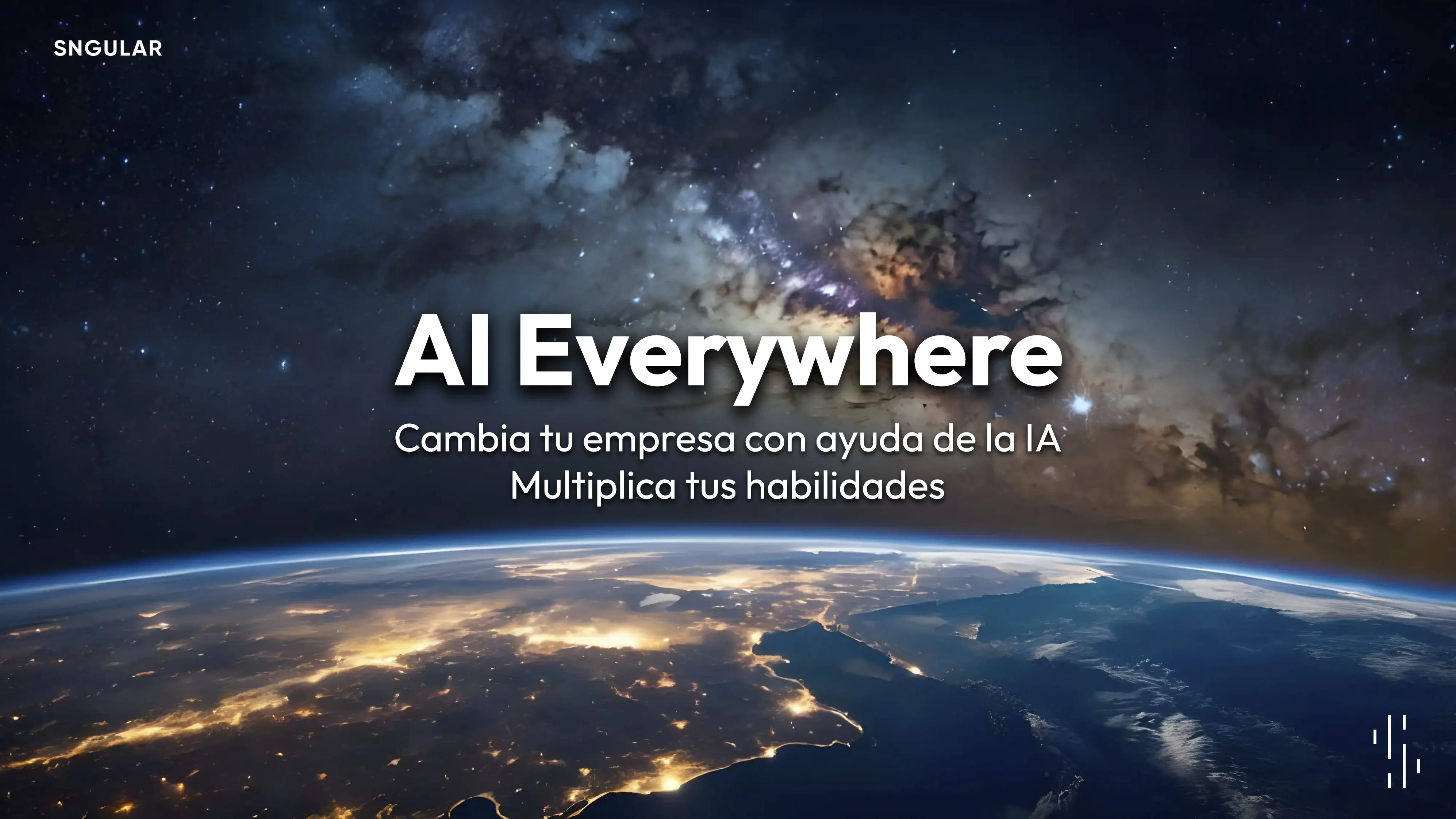
Groundbreaking technologies today that will reshape the innovation landscape in 2025
December 10, 2024
While 2024 Lays the Foundation, 2025 Promises to Solidify Advances and Deliver a Few Surprises
Change is the only constant, especially in the technological sphere.
2024 will be remembered as a year of disruptive innovations and mass adoption of technologies that have reshaped entire sectors and profoundly altered how we live and work. This period marked the rise of tools like Generative Artificial Intelligence, a driver of change that not only captured the global imagination—and fears—but also spurred tangible advancements in fields such as education, healthcare, and design.
As we approach 2025, we reflect not just on achievements but also look forward with curiosity and enthusiasm. What technologies will continue to dominate the landscape? Which ones will emerge as potential disruptors? To answer these questions, we consulted some of our experts at SNGULAR, who shared valuable insights on current trends and the innovations set to shape the near future, with a clear focus on how innovation will keep breaking barriers.
2024: A Year of Affirmation
The Generative AI Revolution
It doesn’t take a tech guru to identify the most celebrated innovation of 2024; you simply need not to have disappeared from the world in the past 12 months. According to Fernando Conde, Director of AI Business Development and Strategy, “this year has marked the beginning of a revolution around Artificial Intelligence, capturing widespread societal attention and becoming a true technological revolution, reaching near science-fiction levels.”
Beyond its media impact, AI has also begun transforming personal productivity. “This year, we’ve seen how this technology, beyond generating and synthesizing content, organizes tasks based on emails, summarizes extensive conversations while suggesting responses, analyzes documents, and creates task lists from meetings. It also connects information across corporate tools, simplifying data and process management,” notes Diego Martín, Microsoft Business Manager.
However, AI’s impact extends beyond these aspects. Javier Martín, Director of GenAI, highlights that “2024 has also witnessed significant recognition in other AI branches, as reflected in the Nobel Prizes, where two awards went to professionals who made substantial contributions in this sector.”

Cybersecurity: An Increasingly Essential Pillar for the Future
The growing reliance on technology has also intensified the need for robust cybersecurity. In 2024, the number of incidents surged, costing organizations over 10 billion euros. Reports also highlighted a rise in cyberattacks, especially targeting critical infrastructure, underscoring the need for greater investment in security.
Many companies are responding with significant investments in cutting-edge security technologies, more robust protocols, and a renewed focus on employee training to foster a strong security culture. For Javier Martín, “the risks we face are becoming increasingly evident, as is the vital role of the technologies, companies, and professionals in this sector.”
Similarly, Arturo Belda, Principal Cybersecurity Consultant, adds: “The approval of the NIS2 Directive has significantly reinforced cybersecurity across Europe, setting stricter requirements for key organizations in sectors such as energy, transport, healthcare, and digital infrastructure.”
The Rise of Efficient and Sustainable Software Development
Is anyone surprised that software development continues to be one of the fastest-growing sectors? In 2024, it was significantly driven by the increased demand for mobile applications, AI integration, and the growing adoption of consumer- and enterprise-valued trends like sustainable coding and contract testing.
Green coding involves developing software applications with minimal environmental impact and low energy consumption by optimizing efficiency and reducing the energy consumed by servers and data centers. Laura Ruiz, Strategy & Positive Impact Innovation Head, emphasizes: “This approach to designing efficient software that minimizes resource use is strongly influencing development teams, who now must consider the environmental impact of their code alongside functionality and user experience. It’s no longer optional; it’s a must.”
On the other hand, contract testing has established itself as a fundamental technique in software development, particularly in microservices architectures and APIs, which are highly popular today. “This methodology offers significant benefits such as early detection of integration issues, reduced testing costs, improved scalability, and greater autonomy for development teams,” says Francisco Moreno, Quality Engineer Director.
Its importance lies in facilitating communication between different software components, allowing teams to build more robust, flexible, and reliable systems in increasingly complex and distributed environments.
However, the shortage of professionals in the software development sector, especially in areas like AI, machine learning, and DevOps, has become a significant challenge and a major headache for organizations. To address this critical gap between supply and demand, strategies such as talent diversification, collaboration with specialized partners, or the proliferation of low-code solutions are becoming key approaches.
Connecting Industries with Industrial Cloud Platforms
In 2024, cloud platforms for specific industries have experienced significant growth. These solutions offer cloud-based services tailored to sectors such as healthcare, finance, manufacturing and retail, among others, addressing the unique needs of each industry.
For Ramón García, Director of Marketing and Partners, “these platforms stand out for providing preconfigured solutions tailored to specific industries, with advanced data analytics capabilities and the integration of technologies such as artificial intelligence, the Internet of Things (IoT), and cutting-edge cybersecurity. They also offer the flexibility to scale according to business needs, with the main goal of improving operational efficiency and fostering innovation.”
The development of these solutions reflects the growing demand for more specialized technologies that address the unique challenges of various sectors, enabling companies to optimize their processes and maintain a competitive edge in an increasingly digital and competitive business landscape.

Technologies Transforming the Boundaries of Human Dignity
“It’s a fact that technology has the potential to transform global health and enhance human dignity by addressing medical and social problems that currently cause suffering and inequality,” comments Carlos Guardiola, Chief Innovation Officer. Suffering is evident because it directly affects individuals, but inequality can be less visible. This includes economic inequality (access to therapy) and the stigmatization or marginalization of certain groups (patients).
CRISPR gene editing and computational chemistry have stood out this year as technologies with immense potential to transform global health and improve human dignity.
CRISPR has proven its ability to correct severe genetic disorders, such as sickle cell anemia, with the approval of the first Casgevy medication in the United States, the United Kingdom, and Europe. Simultaneously, advances in protein modeling using artificial intelligence have been recognized with the Nobel Prize in Chemistry.
These technologies promise to reduce inequalities in access to treatments, particularly in vulnerable communities, improving quality of life. However, they also raise significant ethical dilemmas, such as the risks of eugenics or the potential creation of biological weapons, emphasizing the need for a deep ethical analysis of technological innovation.
A Journey Toward 2025
Looking ahead to 2025, the technological landscape is poised to be a hotbed of innovations that will redefine our interaction with the digital world, enabling a qualitative leap to transform industries and offering smarter, safer, more powerful, and personalized solutions to the immediate challenges of the future.
Artificial Intelligence Speeds Up
As expected, AI will continue its rapid growth in 2025, impacting various sectors and aspects of life. According to Fernando Conde, “Generative AI, which creates original content, will become more sophisticated, being trained with very different sources than what we’re accustomed to. Instead of general texts or images, it will utilize complex scientific data, such as protein sequences, genomes, or information derived from astrophysical instruments.”
This approach will pave the way for disruptive advancements across various disciplines, including biological sciences, medicine, chemistry, physics, materials science, and even social sciences, enabling unprecedented progress in understanding and addressing global challenges.
For Diego Martín, “2025 will be the year of autonomous agents or copilots, an evolution of traditional conversational agents. These systems operate independently, integrating multiple layers of knowledge, such as the web, customized knowledge bases, external connections, and their own training.” These agents interact through conversational interfaces, enabling business process automation and optimizing workflows.
Quantum Innovation and Clean Energy Solutions
Quantum machine learning will emerge in 2025 as one of the most promising areas, representing the convergence of two revolutionary fields: quantum computing and machine learning. This technological synergy has the potential to exponentially expand our processing capacity, allowing us to tackle computational problems that are currently nearly insurmountable.
“Quantum computing is not just a more powerful calculation tool; it’s a new paradigm that could ensure the growth of increasingly complex technological infrastructures,” says Javier Martín. Its ability to manage multiple states simultaneously opens unimagined horizons in fields like cryptography, molecular simulation, and big data analysis.
In the energy sector, although nuclear fusion has yet to reach sufficient maturity for immediate projections, research into low-pollution energy generation technologies remains a beacon of hope. Gradual advances in this area suggest we are closer than ever to sustainable solutions.
This doesn’t mean that significant breakthroughs in green energy can’t occur in 2025, but it does highlight the need for responsible consumption by both companies and users. “Sustainability has become a core pillar in the design and development of digital products. Companies have an increasing responsibility to adopt sustainable practices, not just for ethical and regulatory reasons but also for the strategic opportunities this offers,” argues Laura Ruiz.
Cybersecurity: No Longer a Game of Waiting and Reacting
In an environment where digital threats continuously evolve, adopting a proactive strategy is essential to protect critical assets and minimize risks.
Continuous Threat Exposure Management (CTEM) is set to emerge in 2025 as one of the most advanced strategies in cybersecurity. CTEM shifts the traditional reactive approach to a proactive one, continuously evaluating threats and mapping an organization's digital exposure. This enables anticipation of potential attacks, real-time identification of vulnerabilities, and reinforcement of defenses before risks materialize.
Through dynamic analysis and adaptive preventive measures, CTEM not only enhances technological resilience but also significantly reduces the likelihood of critical incidents, establishing itself as a key standard in risk management.
According to Gartner, by 2025, organizations that prioritize their security investments based on a continuous exposure management program will be three times less likely to experience a data breach. "CETEM is not just a tool; it is a philosophy that positions security as an adaptive and continuous process," says Arturo Belda.
Meta-Innovation: Evolution or Eternal Promise?
Carlos Guardiola speculates, “I’d like 2025 to be the year when new experiential models for accessing information become a reality. Personally, I’ve been collecting headlines about the promises and disappointments of Virtual Reality since 2015. The truth is, sales of VR consoles and games have not taken off, and if the gaming industry (characterized by being an experimental and early-adopting collective) does not meet the expectations of new gaming experiences, it’s hard to imagine other sectors doing so.”
The concept of the metaverse exemplifies this cycle of inflated expectations and disappointment, accumulating investments, headlines, and events without achieving a tangible market deployment. Perhaps spatial computing, an increasingly popular technology, might spark a redefinition of the sector.
This context provides an ideal laboratory for meta-innovation, analyzing the cycles of technological adoption, the creation of interest, and their market impact. Will 2025 be the year of a breakthrough or another year of unmet expectations?
A Final Reflection on 2025
The technological trends on the horizon for 2025 present an equally fascinating and challenging landscape (and plenty of hype). Technological innovation progresses at an accelerated pace, but success remains rooted in our ability to adapt, collaborate, and integrate these technologies efficiently and strategically.
While staying informed about new tools and platforms is crucial, the real value lies in understanding how these technologies can transform industries and society as a whole. It’s not just about adopting the latest technology but identifying how we can use it to solve complex problems, create new opportunities, and ensure business success and growth.
Our latest news
Interested in learning more about how we are constantly adapting to the new digital frontier?

Insight
April 8, 2025
Privacy at risk, what do they know about you and how can you protect yourself?

Insight
April 7, 2025
World Health Day in the AI revolution era

Tech Insight
April 2, 2025
🧐 What is Mockoon and why should you use it?

Tech Insight
March 26, 2025
The Seven Phases of a Cyberattack: A Detailed Look at the Cyber Kill Chain
